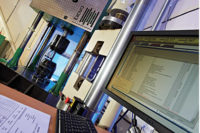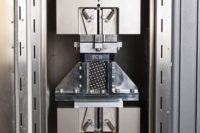Aerospace manufacturers are continually striving to reduce the running costs of their components through reduced weight, improved efficiency or longer service periods, making them more attractive to their market. This can be done by introducing advanced materials, e.g. composites, or improved design, such as sharklet fins on the tips of wings. For aerospace engines this can be done by reducing weight and/or increasing temperatures and pressures.
Recently, this expansion of the performance envelope has been enabled by the introduction of ceramic matrix composites (CMCs) into engine components. CMCs consist of ceramic fibers embedded in a ceramic matrix.
CMCs offer many of the advantages of conventional technical ceramics, namely high melting temperatures, modulus, and hardness. But while conventional ceramics are limited by brittle failure characteristics, low ductility and low fracture toughness, CMCs exhibit increased crack resistance, higher levels of strain to failure and improved thermal shock resistance. Similar to most composites, this is due to the fact that the embedded ceramic fibers in a ceramic matrix allow for a load path through the material even as cracks propagate through the matrix. The subsequent improvement in fracture toughness and ductility allows for the use of CMCs in the high stress, high temperature environment of an engine. Applications within the engine would be items such as combustion chamber liners, stator vanes and turbine blades.
The introduction of any new material into such critical engine items is preceded by an intense period of material testing and evaluation and the fatigue and creep testing methods of CMC materials introduces greater challenges than conventional metals. These two test types are commonly used when defining the allowable and life cycle of an engine.
Engineering fatigue is the repeated application of stress or strain on a component at levels below what would normally cause any permanent deformation or failure. Each application and removal of the applied force is called a cycle and the shape of the load application is the waveform. How fast a cycle is applied is called the frequency. Waveforms can vary, but CMC tests are variants of three basic types.
Creep is the application of a static load at stress levels lower than what would normally cause failure.
For both fatigue and creep testing, damage is built on a microscopic level within the material during test, eventually forming short cracks that lead to fracture as the remaining cross section can no longer support the applied load.
For all materials, sample machining parameters are critical to correctly reproduce surface conditions that accurately represent real components without introducing features that would unrealistically alter the mechanical properties. Additional care must be taken when machining composite coupons from components or panels to avoid delamination which can have a deleterious effect on properties. For CMCs, 3-D CT scanning is generally used to assure the absence of any defects or imperfections that may influence the test results.
In general, because of their use in high temperature areas of an engine, most testing of CMCs is performed in the range of 600 to 1,300 C. This adds complexity to the testing setup as the materials used to manufacture fixture and fittings, normally metallic, are limited to approximately 1,000 C. This has led to a general trend in using low profile furnaces to heat only the critical test section of a CMC test specimen. It requires the gripping to be positioned outside of the furnace and remain warm, permitting the use of lower use temperature metal alloys for fixturing.
Due to the necessity of using warm gripping solutions, the furnace size is minimized so CMC testing has been limited to coupons with relatively short gage lengths and sub-element features.
The low profile CMC furnace uses a different technology to the conventional, which uses coils of wire around a ceramic tube. The CMC has exposed ceramic elements that heat the specimen through radiation and conduction. Due to the small thermal mass of the CMC furnaces, heating rates can be a lot higher, turning heating times to minutes rather than hours. The temperature is controlled to not differ over the duration of a test by more than 3 C for temperatures up to 1,000 C, or more than 6 C for higher temperatures. Additionally, temperature gradients along the critical test section must also be minimized, and will not differ by more than 1% from one area to another.
The furnace is controlled by platinum/platinum-rhodium (R-type) thermocouples, insulated with either mineral or with a ceramic tube. The number and spacing of the thermocouples will depend on the length of the critical test section. However, contact with platinum can lead to chemical reactions with the CMC that will lead to poor test results and so the thermocouples are held close to, but not touching, the specimen surface. Therefore, a furnace survey is conducted with one set of four thermocouples attached to a representative sample, and another set in close approximation to the specimen where they would be located for the test. This allows a correlation between what the test thermocouples read and the actual temperature of the specimen.
Due to the additional complexities in testing composite materials in strain control, CMC testing tends to be in load control with strain monitoring. The strain is monitored through an edge contacting ceramic probe type extensometer.
The strains experienced during CMC testing are small, and the order of magnitude is lower than for metals. Where a typical metallic strain controlled test may be subjected to 0.4% strain, the strains for a CMC will be ~ 0.04%. This means the extensometer has to be very sensitive and calibrated to a low level. Typically, 1% strain is considered full scale for most extensometers.
Care has to be taken when placing the extensometer on the specimen surface as the sharp ends can introduce micro scratches and the uneven nature of CMC surfaces can mean the extensometer can slide during testing, leading to a sudden offset in the test data.
Given the sensitivity of the instrumentation, ambient conditions within the laboratory must be tightly controlled. This not only includes temperature, but air flow and vibration. The extensometers require water cooling to minimize thermal drift and the water flow has to be low flow and must be isolated to avoid strong air currents which can influence strain readings.
Fatigue and creep testing is generally undertaken at the stresses seen by the component in the engine and can vary between 100 to 200 MPa (15 to 30 ksi).
Good load train alignment for axial testing is critical in keeping any bending stresses to a minimum, and previous studies on alignment have shown the detrimental effect on test results. For metallic test pieces, the allowable percentage of bending is defined within the test standard and is usually 5% for fatigue and 10% for creep. However for materials such as CMCs that have low ductility compared to metals, the effects of misalignment can be magnified and subsequently so can the effect on results. Therefore it is usual to have both fatigue and creep allowable percentage bending limited to 3%. This can be achieved by using fixed linear bearings in the loading train.
For fatigue testing, frequencies have to be limited due to the potential of internal friction altering the specimen temperature and taking it outside test tolerance, and are generally between 0.001 and 30 Hz. However, extensometry is limited to lower frequency testing due to extensometer stability on the rougher CMC surface topography.
Various test information can be recorded and supplied depending on customer requirements. Load, displacement, strain and temperature can be logged and these can be used to generate load/strain/temperature against cycle plots or load against strain/displacement loop plots.
Test durations are dependent on a variety of factors relating to the material properties and test conditions. Some tests may last only seconds, while others could last from hours to days to weeks. Because of these extended timescales, long-term stability of laboratory ambient environmental conditions are critically important. In addition, an uninterruptable power supply (UPS) should be used to allow continued running, or controlled shut down, of a test frame.
As with most composite materials, the failure mechanism in tension generally initiates at a micro level in the matrix. Once the matrix and fibers begin to lose intimate contact, this can then lead to fiber pull-out, delamination and a net tension failure.
Ceramic Matrix Composites have come a long way in the past decade in their ability to have sustained strength at high temperatures. However there is still a considerable amount of characterization required to develop a database to allow these materials to be considered “airworthy.” As CMCs continue to evolve, so will the need to continue these types of high temperature tests to suit their applications.









